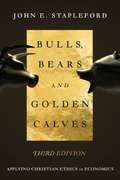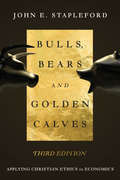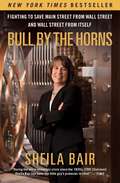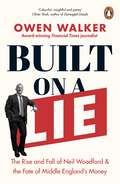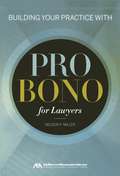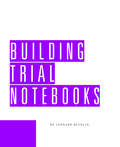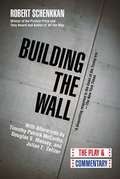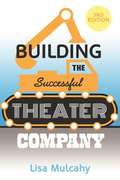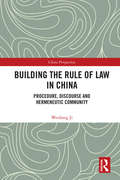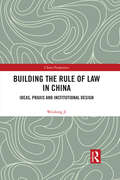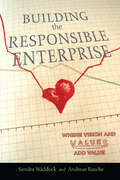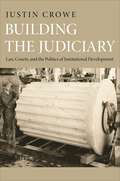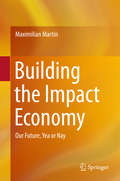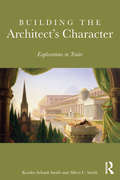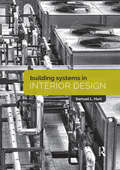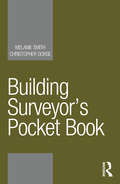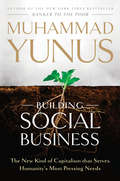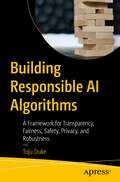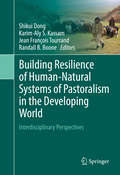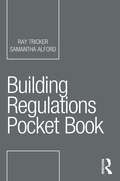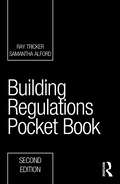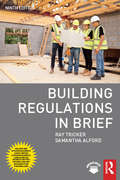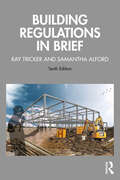- Table View
- List View
Bulls, Bears and Golden Calves: Applying Christian Ethics in Economics
by John E. StaplefordSelf-interest, economic efficiency and private property rights are among the most basic assumptions of market economics. But can an economic theory built on these assumptions alone provide adequate insight into human nature, motivation and ultimate goals to guide our economic life? The author says no, along with those economists who recognize the limits of their discipline. He insightfully shows us in detail how ethics are inextricably intertwined with economic life and analysis. Writing from a Christian ethical perspective, he interacts with seven standard introductory economics texts, exploring the moral challenges embedded in various macro-, micro- and international economic theories and outlining a faithful response to them. The third edition includes two new chapters on economics as a science and global poverty plus expanded discussions of entitlements, government debt, healthcare reform and immigration reform. This book will be especially useful for introductory courses in economics.
Bulls, Bears and Golden Calves: Applying Christian Ethics in Economics
by John E. StaplefordSelf-interest, economic efficiency and private property rights are among the most basic assumptions of market economics. But can an economic theory built on these assumptions alone provide adequate insight into human nature, motivation and ultimate goals to guide our economic life? John Stapleford says no, along with those economists who recognize the limits of their discipline. He insightfully shows us in detail how ethics are inextricably intertwined with economic life and analysis. Writing from a Christian ethical perspective, he interacts with seven standard introductory economics texts, exploring the moral challenges embedded in various macro-, micro- and international economic theories and outlining a faithful response to them. The third edition includes two new chapters on economics as a science and global poverty plus expanded discussions of entitlements, government debt, healthcare reform and immigration reform. Keyed to seven of the most widely used introductory economics texts—Gwartney, Stroup Sobel; Mankiw; Mansfield Behravesh; McConnell Brue; Miller; Samuelson Nordhaus; and Stiglitz—this book will be especially useful for introductory courses in economics.
Bull by the Horns: Fighting to Save Main Street from Wall Street and Wall Street from Itself
by Sheila BairNEW YORK TIMES and WALL STREET JOURNAL BESTSELLERThe former FDIC chairwoman, and one of the first people to acknowledge the full risk of subprime loans, offers a unique perspective on the financial crisis.Appointed by George W. Bush as the chairman of the Federal Deposit Insurance Corporation (FDIC) in 2006, Sheila Bair witnessed the origins of the financial crisis and in 2008 became—along with Hank Paulson, Ben Bernanke, and Timothy Geithner—one of the key public servants trying to repair the damage to the global economy. Bull by the Horns is her remarkable and refreshingly honest account of that contentious time and the struggle for reform that followed and continues to this day.
Built on a Lie: The Rise and Fall of Neil Woodford and the Fate of Middle England’s Money
by Owen WalkerHe was the most celebrated and successful British investor of his generation - but it was all built on a lie. Neil Woodford spent years beating the market; betting against the dot com bubble and the banks before the financial crash in 2008, making blockbuster returns for investors and earning himself a reputation of 'the man who made Middle England rich'.But, in 2019, Woodford's asset management company collapsed, trapping hundreds of thousands of rainy-day savers in his flagship fund and hanging £3.6 billion in the balance.In Built on a Lie, Financial Times reporter Owen Walker reveals the disastrous failings of Woodford, the greed at the heart of his operation and the full, jaw-dropping story of Europe's biggest investment scandal in a decade.'Vital financial journalism with heart' Emma Barnett, broadcaster'This is a must read!' Vince Cable, former leader of the Liberal Democrats'Reads like a rip roaring tale of a corporate high wire act' John McDonnell, former Shadow Chancellor'Should be sold with a bottle of blood-pressure pills' Edward Lucas, The Time
Building Your Practice with Pro Bono for Lawyers
by Nelson P. MillerLawyers know that pro bono service is often the most interesting and fulfilling work of their careers. Yet few understand the financial and career benefits that pro bono work can yield. Building Your Practice with Pro Bono for Lawyers explains 10 pro bono opportunities that will broaden, deepen and strengthen your paying practice and legal career. Nelson Miller, an experienced pro bono practitioner, offers practical advice about helping underserved populations such as veterans, prisoners, immigrants, needy children, the homeless, and people with disabilities. This book will help you: * Develop the inter-cultural skills to serve pro bono clients * Learn from other lawyers by sharing pro bono cases * Gain new confidence and skills doing pro bono work * Fulfill your interest in specific pro bono client populations * Serve charitable organizations promoting pro bono * Comply with ethics rules governing pro bono work * Rejuvenate your paying practice through pro bono
Building Trial Notebooks
by Leonard BucklinLeonard Bucklin's proven and highly-visible approach to litigation preparation will ensure that your cases and you are always ready for the next skirmish... even when unanticipated issues and arguments arise. Mr. Bucklin, who has been identified by the International Academy of Trial Lawyers as one of the top 500 trial lawyers in the U.S., created and polished his litigation preparation system over decades of high-stakes trial work. Now the Bucklin system is available to help you: Plan all aspects of your case so you hit every important point Organize your case from opening to closing Materially reduce your trial preparation time Assemble any case at low cost Keep each document at your fingertips Place litigation matters on staff auto-pilot Keep opposing counsel on the defensive Earn the respect of the court and opposing counsel with your organization and readiness The Bucklin litigation preparation system will also make you and your case settlement-ready. And your readiness, confidence, and organization will be visible. At depositions and conferences, defense counsel will see that you are prepared and focused, your trial notebook is steadily growing in size and value, and your strategies and forms are painfully effective.
Building the Wall: The Play and Commentary (Oberon Modern Plays Ser.)
by Julian E. Zelizer Douglas S. Massey Robert Schenkkan Timothy Patrick McCarthyIn the tradition of Hamilton and Angels in America, a powerful, politically charged, dystopian drama that couldn’t be more timely. Written in a “white-hot fury” on the eve of the 2016 election, the stunning new play by Pulitzer Prize– and Tony Award–winning dramatist Robert Schenkkan is creating a nationwide sensation. Bypassing the usual development path for plays, it has been signed up to open in five theaters across America in a National New Play Network Rolling World Premiere, starting in Los Angeles (March) and Denver (April) and continuing in the Washington, DC, area, Tucson, and Miami, with more productions to follow, including in Santa Fe and New York City. Building the Wall lays out in a harrowing drama the consequences of Donald Trump’s anti-immigration campaign rhetoric turned into federal policy. Two years from now, that policy has resulted in the mass round-up of millions of illegal aliens, with their incarceration overflowing into private prisons and camps reminiscent of another century. The former warden for one facility is awaiting sentencing for what happened under his watch. In a riveting interview with a historian who has come seeking the truth, he gradually reveals how the unthinkable became the inevitable, and the faceless illegals under his charge became the face of tragedy. The play is accompanied by commentary from three prominent scholars: on the real purpose of the border wall, our dark nativist history of restricting immigration, and the tradition of political protest in art.
Building the Successful Theater Company
by Lisa MulcahyWhat makes a theater company successful? Lisa Mulcahy poses the question to leaders from nineteen of the country’s most diverse and vital theater companies from the recent past and present, and offers answers in Building the Successful Theater Company. Producers, stage managers, directors-anyone dreaming of running a theater troupe-will benefit from the practical guidance, amusing anecdotes, and sincere advice in this peek behind the curtains of the often difficult, always seductive, profession of theater. With five additional companies profiled in this fully revised third edition, Building a Successful Theater Company features: The LABrynth Theater Company New Paradise Laboratories National Theatre of the Deaf Shotgun Players Asian-American Theatre Company Steppenwolf Theater Company The Pasadena Playhouse La Jolla Playhouse Chicago City Limits Berkeley Repertory Theatre Arena Stage’s The Living Stage Theatre Company Mixed Blood Theatre Company Horizons Theatre Wheelock Family Theatre L.A. Theatre Works A Traveling Jewish Theatre Jean Cocteau Repertory Bailiwick Repertory New Repertory TheatreNew chapters cover funding and financial aspects, maximizing a company's potential through powerful social media use, and creating successful partnerships by teaming up with corporate sponsors and establishing artistic collaborations. Stage veterans reveal advice on everything from locating performance space, to developing a business plan, to and rehearsing and publicizing productions in this invaluable guide to creating or growing a theater company.Allworth Press, an imprint of Skyhorse Publishing, publishes a broad range of books on the visual and performing arts, with emphasis on the business of art. Our titles cover subjects such as graphic design, theater, branding, fine art, photography, interior design, writing, acting, film, how to start careers, business and legal forms, business practices, and more. While we don't aspire to publish a New York Times bestseller or a national bestseller, we are deeply committed to quality books that help creative professionals succeed and thrive. We often publish in areas overlooked by other publishers and welcome the author whose expertise can help our audience of readers.
Building the Rule of Law in China: Procedure, Discourse and Hermeneutic Community (China Perspectives)
by Weidong JiAfter thirty years of Mao era (1949-1979) which was struggle-based, the Communist Party of China has begun to change its position as a pioneering revolutionary party, evolving into a universal ruling party that transcends class interests. Meanwhile, administrative and judicial reforms oriented toward a more efficient, serving government and the rule of law have been actively carried out. As the earliest work on constructive jurisprudence of new proceduralism in China, this book elucidates some of the most critical problems in the process of constructing a legal order and realizing institutional innovation in China: democracy, fair and reasonable procedure, interpretation techniques, cognitive ability of legislation, position and function of the jurist group, and professional ethics, etc. Besides, it expounds five pairs of contradictions in the modernization process of Chinese legal system, namely, substantial and procedural justice, moral and legal debates, formal and reflective rationality, the major responsibility on bureaucrats and lawyers, and the motivation of public welfare and profit, and explores appropriate approaches to combine the different factors. Scholars and students in Chinese legal and social transformation studies will be attracted by this book. Furthermore, it will help different civilizations conduct rational dialogues on justice and order.
Building the Rule of Law in China: Ideas, Praxis and Institutional Design (China Perspectives)
by Weidong JiAfter thirty years of Mao era (1949-1979) which was struggle-based, the Communist Party of China has begun to change its position as a pioneering revolutionary party, evolving into a universal ruling party that transcends class interests. Meanwhile, administrative and judicial reforms oriented toward a more efficient, serving government and the rule of law have been actively carried out. As the earliest work on constructive jurisprudence of new proceduralism in China, this book elaborates on the ideological confrontation on the "direction of China". It includes academic debates on politics and law which the author has been involved in, and top-level institutional design in China. Besides, this book introduces, analyzes and evaluates the focus of Chinese contemporary jurisprudence, making some critical summarizing propositions on the practical experiences. A review of Western contemporary jurisprudence and the forefront of legal research is also covered, aiming to provide ideological resources for the rule of law in China. Scholars and students in Chinese legal and social transformation studies will be attracted by this book. Furthermore, it will help different civilizations conduct rational dialogues on justice and order.
Building the Responsible Enterprise: Where Vision and Values Add Value
by Andreas Rasche Sandra WaddockBuilding the Responsible Enterprise provides students and practitioners with a practical, yet academically rooted, introduction to the state-of-the-art in sustainability and corporate social responsibility. The book consists of four parts, highlighting different aspects of corporate responsibility. Part I discusses the context in which corporate responsibility occurs. Part II looks at three critical issues: the development of vision at the individual and organizational levels, the integration of values into the responsible enterprise, and the ways that these building blocks create added value for a firm. Part III highlights the actual management practices that enable enterprises to achieve excellence, focusing on the roles that stakeholder relationships play in improving performance. The book concludes with a conversation about responsible management in the global village, examining the emerging infrastructure in which enterprise finds itself today. Throughout the text, cases exemplify key concepts and highlight companies that are guiding us into tomorrow's business environment.
Building the Judiciary: Law, Courts, and the Politics of Institutional Development (Princeton Studies in American Politics: Historical, International, and Comparative Perspectives #129)
by Justin CroweHow did the federal judiciary transcend early limitations to become a powerful institution of American governance? How did the Supreme Court move from political irrelevance to political centrality? Building the Judiciary uncovers the causes and consequences of judicial institution-building in the United States from the commencement of the new government in 1789 through the close of the twentieth century. Explaining why and how the federal judiciary became an independent, autonomous, and powerful political institution, Justin Crowe moves away from the notion that the judiciary is exceptional in the scheme of American politics, illustrating instead how it is subject to the same architectonic politics as other political institutions. Arguing that judicial institution-building is fundamentally based on a series of contested questions regarding institutional design and delegation, Crowe develops a theory to explain why political actors seek to build the judiciary and the conditions under which they are successful. He both demonstrates how the motivations of institution-builders ranged from substantive policy to partisan and electoral politics to judicial performance, and details how reform was often provoked by substantial changes in the political universe or transformational entrepreneurship by political leaders. Embedding case studies of landmark institution-building episodes within a contextual understanding of each era under consideration, Crowe presents a historically rich narrative that offers analytically grounded explanations for why judicial institution-building was pursued, how it was accomplished, and what--in the broader scheme of American constitutional democracy--it achieved.
Building the Impact Economy: Our Future, Yea or Nay
by Maximilian MartinThis book develops a comprehensive framework for creating sustainable new business approaches on a massive scale. It relates the power of entrepreneurship, investment and technology to four areas in which progress is urgently needed to get out of the world's current impasse. These are: game-changing innovations in companies; a way forward for the global fashion industry that reconciles competitiveness and worker dignity; turning around the energy crisis; and restoring capital markets to being the funders of human progress and prosperity that they once were--the pieces of the puzzle that is our future. Numerous case studies and actionable guidelines show how to concretely get the job done.
Building the Fourth Estate: Democratization and the Rise of a Free Press in Mexico
by Chappell H. LawsonIn the wake of the recent ground-breaking democratic reforms in Mexico, including this summer's unprecedented election of a non-PRI presidential candidate for the first time in almost a century, this book shows how the Mexican media played a crucial role in the country's democratic transformation.
Building the Architect's Character: Explorations in Traits
by Kendra Schank Smith Albert C. SmithAn understanding of architects’ character traits can offer important insights into how they design buildings. These traits include leadership skills necessary to coordinate a team, honest and ethical behavior, being well educated and possessing a life-long love of learning, flexibility, resourcefulness, and visionary and strategic thinking. Characteristics such as these describe a successful person. Architects also possess these traits, but they have additional skills specifically valuable for the profession. These will include the ability to question the use of digital media, new materials, processes, and methods to convey meaning in architectural form. Although not exhaustive, a discussion of such subjects as defining, imaging, persuading, and fabricating will reveal representational meaning useful for the development of an understanding of architects’ character. Through the analogies and metaphors found in Greek myth, the book describes the elusive, hard-to-define characteristics of architects to engage the dilemmas of a changing architectural landscape. Building the Architect’s Character: Explorations in Traits examines traditional and archetypal characteristics of the successful architect to ask if they remain relevant today.
Building Systems in Interior Design
by Samuel L. Hurt<p>Building Systems in Interior Design takes an entirely new approach to teaching this essential topic for Architects, Designers and Building Engineers. Written to prepare students for the real world and packed with practical examples, the book will foster an understanding of specific issues that are critical to those features of technical systems that most directly affect design. The book stresses the ever-present nature of these systems: they are everywhere, all the time. <p>Taking a design oriented view, it outlines what can and cannot be done, and provides the student with the know-how and confidence to defend and promote their design intent when working with other industry professionals. <p>Covering lighting, HVAC, plumbing and much more, the book is packed with key features to aid learning including: <p> <li>Numerous illustrations, plans and photographs <li>Key terms defined in an extensive glossary <li>Chapter introductions that identify key concepts and chapter summaries to re-visit those key concepts <li>Professional design tips <li>And a detailed bibliography and web links</li> <p> <p>This book is not only a core text for interior design, building systems engineering and architecture students but will become an essential working reference through their careers.</p>
Building Surveyor’s Pocket Book (Routledge Pocket Books)
by Melanie Smith Christopher GorseBuilding Surveyor’s Pocket Book is an accessible encyclopaedia of matters vital to building surveyors. Well-illustrated with diagrams, pictures, tables, and graphs, it covers all essential elements of building pathology, building performance, and building construction terminology in a simple, accessible way for the practitioner and student. This Pocket Book provides a practical and portable reference text, working as a first-stop publication for those wishing to refresh their knowledge or in need of guidance on surveying practice. Working through fundamental principles in key practice areas, the book is not overly bound by the regulation and legislation of one region, and the principles can be applied internationally. This book is ideal reading for individual surveyors, practitioners, and students in building surveying, facilities management, refurbishment, maintenance, renovation, and services management. It is also of use for those interested in building forensics, building performance, pathology, and anyone studying for their RICS APC. Many other professions in architecture, contracting, engineering, and safety will also find the book of use when undertaking similar practice.
Building Social Business: The New Kind of Capitalism That Serves Humanity's Most Pressing Needs
by Muhammad YunusMuhammad Yunus, the practical visionary who pioneered microcredit and, with his Grameen Bank, won the 2006 Nobel Peace Prize, has developed a visionary new dimension for capitalism which he calls "social business. ” By harnessing the energy of profit-making to the objective of fulfilling human needs, social business creates self-supporting, viable commercial enterprises that generate economic growth even as they produce goods and services that make the world a better place. In this book, Yunus shows how social business has gone from being a theory to an inspiring practice, adopted by leading corporations, entrepreneurs, and social activists across Asia, South America, Europe and the US. He demonstrates how social business transforms lives; offers practical guidance for those who want to create social businesses of their own; explains how public and corporate policies must adapt to make room for the social business model; and shows why social business holds the potential to redeem the failed promise of free-market enterprise.
Building Responsible AI Algorithms: A Framework for Transparency, Fairness, Safety, Privacy, and Robustness
by Toju DukeThis book introduces a Responsible AI framework and guides you through processes to apply at each stage of the machine learning (ML) life cycle, from problem definition to deployment, to reduce and mitigate the risks and harms found in artificial intelligence (AI) technologies. AI offers the ability to solve many problems today if implemented correctly and responsibly. This book helps you avoid negative impacts – that in some cases have caused loss of life – and develop models that are fair, transparent, safe, secure, and robust.The approach in this book raises your awareness of the missteps that can lead to negative outcomes in AI technologies and provides a Responsible AI framework to deliver responsible and ethical results in ML. It begins with an examination of the foundational elements of responsibility, principles, and data. Next comes guidance on implementation addressing issues such as fairness, transparency, safety, privacy, and robustness. The book helps you think responsibly while building AI and ML models and guides you through practical steps aimed at delivering responsible ML models, datasets, and products for your end users and customers. What You Will LearnBuild AI/ML models using Responsible AI frameworks and processesDocument information on your datasets and improve data qualityMeasure fairness metrics in ML modelsIdentify harms and risks per task and run safety evaluations on ML modelsCreate transparent AI/ML modelsDevelop Responsible AI principles and organizational guidelinesWho This Book Is ForAI and ML practitioners looking for guidance on building models that are fair, transparent, and ethical; those seeking awareness of the missteps that can lead to unintentional bias and harm from their AI algorithms; policy makers planning to craft laws, policies, and regulations that promote fairness and equity in automated algorithms
Building Respected Companies
by Jordi CanalsThe current financial crisis has deep macroeconomic roots, but the dominant view of the firm has made the crisis deeper and more devastating. Over the past few decades, maximizing shareholder value has become the main objective of the firm. Chief executives have been keen on this objective because their economic incentives have been clearly associated with stock market performance. Unfortunately, this has driven many CEOs to make terrible decisions based on short-termism and greed. In this way, the firm has become the object of anger, criticism and cynicism. In Building Respected Companies, Jordi Canals argues that we must address this problem by developing companies that serve society, not just their shareholders. This requires a new perspective of what a firm is, what the purpose of the firm in society should be and what the role of the board of directors and senior executives should be.
Building Resilience of Human-Natural Systems of Pastoralism in the Developing World: Interdisciplinary Perspectives
by Shikui Dong Karim-Aly S. Kassam Jean François Tourrand Randall B. BooneThis edited volume summarizes information about the situational context, threats, problems, challenges and solutions for sustainable pastoralism at a global scale. The book has four goals. The first goal is to summarize the information about the history, distribution and patterns of pastoralism, as well as to identify the importance of pastoralism from social, economic and environmental perspectives. The results of an empirical investigation of the environmental and socio-economic implications of pastoralism in representative pastoral regions in the world are also incorporated. The second goal is to argue that breaking coupled human-natural systems of pastoralism leads to degradation of pastoral ecosystems, as well as to create an analysis framework to assess the vulnerability of worldwide pastoralism. Our analysis framework provides approaches to help comprehensively understand the transitions and the impacts of human-natural systems in the pastoral regions in the world. The third goal is to identify the successful models in promoting coupled human-natural systems of pastoralism and to learn lessons of breaking coupled human-cultural pastoralism system through examining the representative cases in regions including Central Asia, Southern and Eastern Asia, Northern and Eastern Africa, European Alps and South America. The fourth goal is to identify the strategies to build the resilience of the coupled human-natural systems of pastoralism worldwide. We hope that our book can facilitate the further examination of sustainable development of coupled human-natural systems of pastoralism by providing the summaries of existing data and information related to the pastoralism development, and offering a framework for better understanding and analyzing their social, economic and environmental implications.
Building Regulations Pocket Book (Routledge Pocket Books)
by Ray Tricker Samantha AlfordThis handy guide provides you with all the information you need to comply with the UK Building Regulations and Approved Documents. On site, in the van, in the office, wherever you are, this is the book you’ll refer to time and time again to double check the regulations on your current job. The Building Regulations Pocket Book is the must have reliable and portable guide to compliance with the Building Regulations. Part 1 provides an overview of the Building Act Part 2 offers a handy guide to the dos and don’ts of gaining the Local Council’s approval for Planning Permission and Building Regulations Approval Part 3 presents an overview of the requirements of the Approved Documents associated with the Building Regulations Part 4 is an easy to read explanation of the essential requirements of the Building Regulations that any architect, builder or DIYer needs to know to keep their work safe and compliant on both domestic or non-domestic jobs This book is essential reading for all building contractors and sub-contractors, site engineers, building engineers, building control officers, building surveyors, architects, construction site managers and DIYers. Homeowners will also find it useful to understand what they are responsible for when they have work done on their home (ignorance of the regulations is no defence when it comes to compliance!).
Building Regulations Pocket Book (Routledge Pocket Books)
by Ray Tricker Samantha AlfordThe new edition of the Building Regulations Pocket Book has been fully updated with recent changes to the UK Building Regulations and Planning Law. This handy guide provides you with all the information you need to comply with the UK Building Regulations and Approved Documents. On site, in the van, in the office – wherever you are – this is the book you’ll refer to time and time again to check the regulations on your current job. Part 1 provides an overview of the Building Act. Part 2 offers a handy guide to the dos and don’ts of gaining the Local Council’s approval for Planning Permission and Building Regulations Approval. Part 3 presents an overview of the requirements of the Approved Documents associated with the Building Regulations. Part 4 is an easy-to-read explanation of the essential requirements of the Building Regulations that any architect, builder or DIYer needs to know to keep their work safe and compliant on both domestic and non-domestic jobs. Key new updates to this second edition include, but are not limited to: changes to the fire regulations as a result of the Hackitt Review, updates to Approved Document F and L, new Approved Documents covering Overheating (AD-O) and Infrastructure for the charging of electric vehicles (AD-S), amendments to and the reinstatement of the Manual to the Building Regulations. This book is essential reading for all building contractors and sub-contractors, site engineers, building engineers, building control officers, building surveyors, architects, construction site managers as well as DIYers and those who are supervising work in their own home.
Building Regulations in Brief
by Ray Tricker Samantha AlfordThis ninth edition of the most popular and trusted guide reflects all the latest amendments to the Building Regulations, planning permission and the Approved Documents in England and Wales. This includes coverage of the new Approved Document Q on security, and a second part to Approved Document M which divides the regulations for 'dwellings' and 'buildings other than dwellings'. A new chapter has been added to incorporate these changes and to make the book more user friendly. Giving practical information throughout on how to work with (and within) the Regulations, this book enables compliance in the simplest and most cost-effective manner possible. The no-nonsense approach of Building Regulations in Brief cuts through any confusion and explains the meaning of the Regulations. Consequently, it has become a favourite for anyone in the building industry or studying, as well as those planning to have work carried out on their home.
Building Regulations in Brief
by Ray Tricker Samantha AlfordThis tenth edition of the most popular and trusted guide reflects all the latest amendments to the Building Regulations, planning permission and the Approved Documents in England and Wales. This includes coverage of the recent changes to use classes, updated sections on planning permission, permitted development and application fees. We have included the revisions to Approved Document B (as a result of the Hackitt Review), as well as the latest changes to Approved Documents F and L, and the new documents O (overheating) and S (electric vehicle charging points), which come into effect in June 2022. Giving practical information throughout on how to work with (and within) the Regulations, this book enables compliance in the simplest and most cost-effective manner possible. The no-nonsense approach of Building Regulations in Brief cuts through any confusion and explains the meaning of the Regulations. Consequently, it has become a favourite for anyone working in or studying the building industry, as well as those planning to have work carried out on their home. It is essential reading for all building contractors and subcontractors, site engineers, building engineers, building control officers, building surveyors, architects, construction site managers and DIYers.
